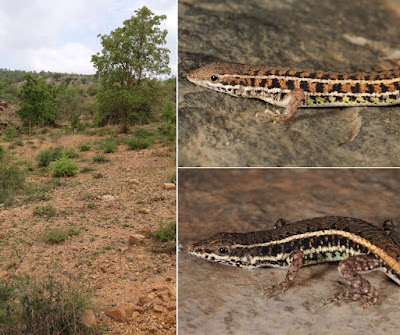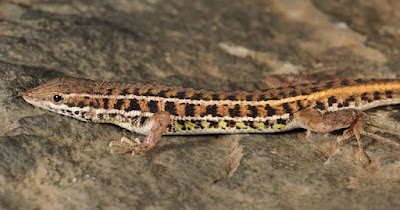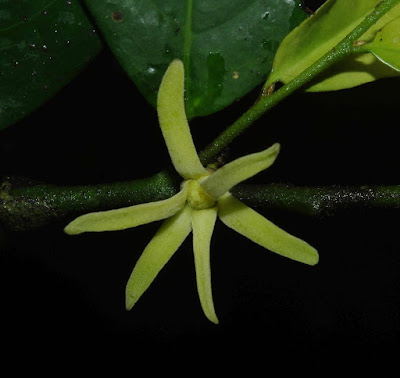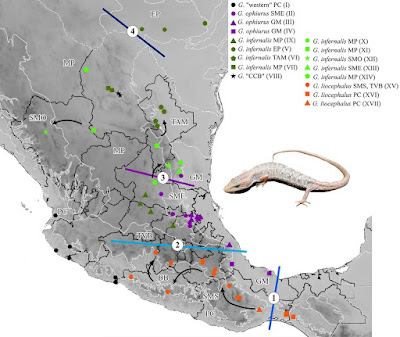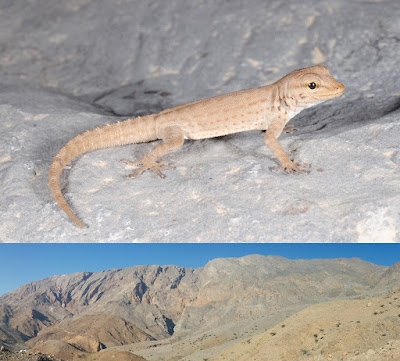 |
| Pristurus r. rupetris of the high altitude robust morphotype. Panoramic view of Wadi Sareen, a Protected Area that includes the only known locality of one of the new species discovered in this study. |
Abstract
Aim
To understand the patterns of genetic, geographical and morphological diversification in the Arabian gecko subspecies Pristurus rupestris rupestris, and to discuss the various processes that generate and shape diversity in arid mountain ranges.
Location
Hajar Mountains, south-eastern Arabian Peninsula.
Methods
We sampled 466 individuals across the entire range of P. r. rupestris in the Hajar Mountains and sequenced one mitochondrial gene for all the samples, and one extra mitochondrial and four nuclear genes for a subset of 75 specimens. A total of 155 individuals were characterized morphologically. Multilocus coalescent-based methods were used for species delimitation, for phylogenetic inference of species trees and to investigate the diversification dynamics. Multivariate statistics were used to analyse morphological data.
Results
Our molecular methods revealed 14 candidate species hidden within the subspecies P. r. rupestris. Diversification started c. 15 Ma, but most of the lineages have evolved in the last 7 Ma of the mountains’ orogeny, producing a mosaic of allopatric taxa. Secondary interchange has occurred between high and low elevation lineages, and along the mountain chain between unrelated lineages formerly separated by mountain blocks. Morphological variation between the 14 candidate species is slight, but a high elevation robust morphotype is identified.
Main conclusions
Our results support the notion that mountain ranges constitute important centres of diversification in arid regions, and also act as ‘species pumps’ into surrounding areas. We also demonstrate that arid mountains may constitute important reservoirs of cryptic diversity, even in common and widespread species. This, and previous evidence, suggest that the Hajar Mountains are a biological hotspot and an important reservoir of diversity. We therefore suggest that these mountains should be a priority focal point for conservation in Arabia.
Keywords: allopatry; Arabia; arid mountains; biodiversity; biogeography; cryptic species; diversification; evolution; systematics
 |
| Photo 1: Pristurus r. rupetris of the high altitude robust morphotype. photo: S. Carranza. |
 |
| Photo 2: Panoramic view of Wadi Sareen, a Protected Area that includes the only known locality of one of the new species discovered in this study. photo: S. Carranza. |
Joan Garcia-Porta, Marc Simó-Riudalbas, Michael Robinson and Salvador Carranza. 2017. Diversification in Arid Mountains: Biogeography and Cryptic Diversity of Pristurus rupestris rupestris in Arabia. Journal of Biogeography. DOI: 10.1111/jbi.12929
The Hidden Biodiversity of Reptiles https://www.ibe.upf-csic.es/home/-/asset_publisher/T2caeLMECPvW/content/id/7612754
Scientists uncover 14 new gecko species within a single subspecies - Oman
http://www.muscatdaily.com/Archive/Oman/Scientists-uncover-14-new-gecko-species-within-a-single-subspecies-4ykk
http://www.muscatdaily.com/Archive/Oman/Scientists-uncover-14-new-gecko-species-within-a-single-subspecies-4ykk
---------------------------------------------------------------
روابط التحميل والمشاهدة، الروابط المباشرة للتحميل
او
شاهد هذا الفيديو القصير لطريقة التحميل البسيطة
كيف تحصل على مدونة جاهزة بآلاف المواضيع والمشاركات من هنا
شاهد قناة منتدى مدونات بلوجر جاهزة بألاف المواضيع والمشاركات على اليوتيوب لمزيد من الشرح من هنا
رابط مدونة منتدى مدونات بلوجر جاهزة بآلاف المواضيع والمشاركات في أي وقت حــــتى لو تم حذفها من هنا
شاهد صفحة منتدى مدونات بلوجر جاهزة بألاف المواضيع والمشاركات على الفيس بوك لمزيد من الشرح من هنا
شاهد صفحة منتدى مدونات بلوجر جاهزة بألاف المواضيع والمشاركات على الفيس بوك لمزيد من الشرح من هنا
تعرف على ترتيب مواضيع منتدى مدونات بلوجر جاهزة بآلاف المواضيع والمشاركات (حتى لا تختلط عليك الامور) من هنا
ملاحظة هامة: كل عمليات تنزيل، رفع، وتعديل المواضيع الجاهزة تتم بطريقة آلية، ونعتذر عن اي موضوع مخالف او مخل بالحياء مرفوع بالمدونات الجاهزة بآلاف المواضيع والمشاركات، ولكم ان تقوموا بحذف هذه المواضيع والمشاركات والطريقة بسيطة وسهلة. ــــــــــــــــــــــــــــــــــــــــــــــــــــــــــــــــــــــــــــــسلامـ.





